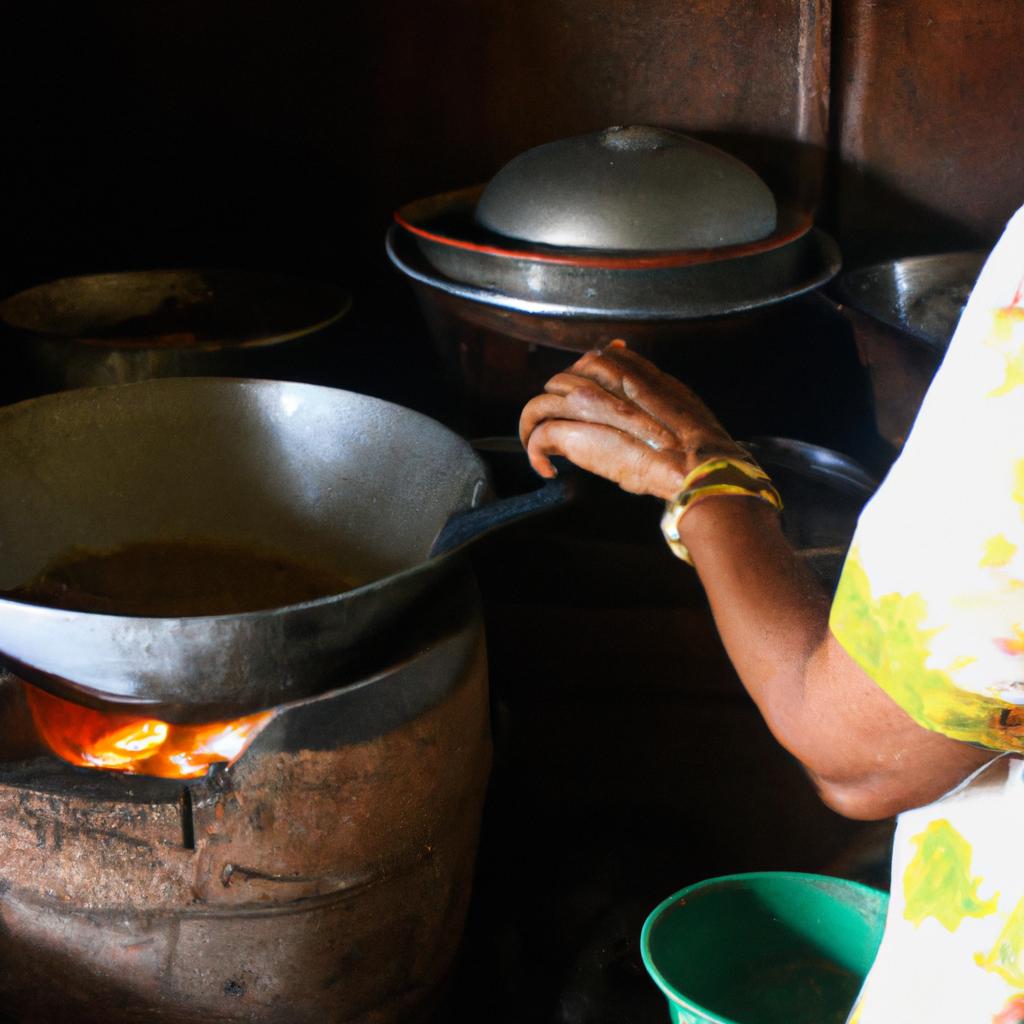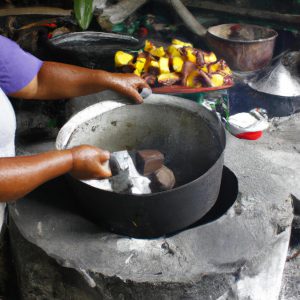Traditional Dishes: Local Cuisine in Travel Directory

Traditional dishes are an integral part of any culture and often provide a window into the history, heritage, and culinary traditions of a particular region. When exploring new destinations, one cannot overlook the importance of indulging in local cuisine to truly immerse oneself in the cultural experience. This article aims to delve into the world of traditional dishes featured in travel directories, shedding light on their significance and offering insights into some notable examples.
For instance, imagine embarking on a gastronomic journey through Italy and stumbling upon a small trattoria tucked away in the narrow streets of Florence. As you browse through the menu, your eyes catch sight of a dish called “Bistecca alla Fiorentina,” known as Florentine steak. Curiosity piqued, you order this renowned Tuscan specialty. The anticipation builds as you await its arrival – a thick-cut T-bone steak seared to perfection over an open flame, seasoned simply with salt, pepper, and olive oil. With each succulent bite revealing layers of flavor and tenderness that can only be achieved through years of tradition and expertise, you realize that this single dish encapsulates centuries-old culinary techniques handed down from generation to generation.
By featuring such traditional dishes in travel directories, travelers gain access to invaluable By featuring such traditional dishes in travel directories, travelers gain access to invaluable insights into the local culture, history, and culinary traditions of a destination. These directories provide detailed information about the ingredients used, cooking methods employed, and even the stories behind these dishes. This allows travelers to make informed choices about what to try and where to find the most authentic versions of these traditional dishes.
Furthermore, travel directories often highlight lesser-known or off-the-beaten-path eateries that specialize in serving these traditional dishes. This not only supports local businesses but also encourages travelers to venture beyond tourist hotspots and discover hidden gems that offer a more immersive and authentic dining experience.
In addition, featuring traditional dishes in travel directories helps preserve culinary heritage by promoting awareness and appreciation for these age-old recipes. It encourages locals to continue practicing their culinary traditions and pass them down to future generations. By showcasing these dishes to a wider audience through travel directories, they are given the recognition they deserve and contribute to the overall preservation of cultural heritage.
Ultimately, incorporating traditional dishes into travel directories elevates the gastronomic experiences of travelers, allowing them to connect with a destination on a deeper level. Through food, they can forge meaningful connections with locals, gain insights into their way of life, and create lasting memories that go beyond mere sightseeing. So next time you plan your travels, don’t forget to consult travel directories for recommendations on traditional dishes – it’s an essential ingredient for an enriching cultural journey.
Must-Try Dishes: Exploring the Authentic Flavors
Imagine yourself strolling down the vibrant streets of a foreign city, tantalized by the scents wafting from local eateries. As you enter one such establishment, your senses are immediately enveloped in an explosion of aromas and flavors that promise to take you on a culinary adventure like no other. Traditional dishes are not only a reflection of a region’s culture but also offer a unique opportunity to experience its authentic flavors. From sizzling street food stalls to cozy family-owned restaurants, these must-try dishes captivate both locals and travelers alike.
One example of a must-try dish is Pad Thai, a quintessential Thai delicacy renowned for its harmonious blend of sweet, sour, and savory flavors. This stir-fried rice noodle dish is typically prepared with shrimp or chicken, mixed with bean sprouts, tofu, peanuts, and aromatic herbs. The exquisite balance of tangy tamarind sauce, spicy chili flakes, and umami-filled fish sauce makes each bite an explosion of taste sensations. Whether enjoyed at a bustling night market or in an upscale restaurant overlooking the Chao Phraya River in Bangkok, Pad Thai embodies the essence of traditional Thai cuisine.
To further entice your taste buds into craving more adventurous experiences abroad, here are some remarkable characteristics found among must-try dishes:
- Rich cultural heritage: These traditional dishes have been passed down through generations and hold significant historical value.
- Culinary craftsmanship: Each dish showcases intricate techniques perfected over time by skilled chefs who dedicate themselves to preserving their culinary heritage.
- Locally sourced ingredients: Must-try dishes often incorporate fresh produce and regional specialties indigenous to the area.
- Social gatherings: Many traditional dishes are associated with communal dining experiences that foster connections between individuals while celebrating shared traditions.
Additionally, let us explore these captivating elements in greater detail through this table:
| Characteristic | Description |
|---|---|
| Rich cultural heritage | Traditional dishes carry the legacy of a region’s history and traditions. |
| Culinary craftsmanship | Expert chefs employ time-honored techniques to create these masterpieces. |
| Locally sourced ingredients | Fresh, local produce enhances the flavors and authenticity of the dish. |
| Social gatherings | These dishes often bring people together in joyful celebrations or feasts. |
In essence, must-try dishes are not only about satisfying one’s hunger but also serve as gateways into understanding different cultures on a deeper level. As we delve further into our exploration of traditional cuisine, let us now uncover the regional specialties that await us in this culinary journey.
Culinary Delights: Uncovering Regional Specialties
Imagine yourself sitting in a charming local restaurant, surrounded by the tantalizing aroma of freshly prepared dishes. As you embark on your culinary journey, let us explore some of the most delightful traditional dishes that will surely captivate your taste buds.
One such dish is the renowned Coq au Vin from France. This classic French delicacy showcases tender chicken cooked with red wine and aromatic herbs, resulting in a rich and flavorful stew. The use of locally sourced ingredients enhances its authenticity, making it an absolute must-try for any food enthusiast visiting France.
To further entice your appetite, here are four remarkable characteristics shared by many traditional dishes across different regions:
- Time-honored recipes handed down through generations.
- Utilization of seasonal and locally sourced ingredients.
- Incorporation of unique cooking techniques native to the region.
- Representation of cultural heritage and traditions.
Let’s delve deeper into these fascinating aspects through the following table:
| Traditional Dishes | Characteristics |
|---|---|
| Coq au Vin (France) | – Prepared using age-old recipe – Features locally produced wine – Slow-cooked for hours to enhance flavors – Reflects French culinary tradition |
| Korean Bibimbap | – Passed down for centuries – Showcases fresh vegetables and rice- Stir-fried with special sauces- Represents Korean cultural identity |
| Mole Poblano (Mexico) | – Recipe dating back to ancient Aztecs- Combines various types of chili peppers- Ground spices hand-pounded using metate- Signifies Mexican gastronomic legacy |
| Rendang (Indonesia) | – Originates from Minangkabau culture- Uses indigenous spices like galangal and lemongrass- Cooked slowly until meat becomes tender and infused with flavors- Symbolizes Indonesian culinary heritage |
As you venture into the world of traditional cuisine, these dishes stand as testaments to the pride and dedication embedded within local gastronomy. By preserving time-honored recipes, utilizing regional ingredients, and incorporating unique cooking techniques, these culinary creations immerse us in a cultural experience like no other.
Now let us explore the art of preserving traditional cooking methods through an exploration of time-honored recipes
Time-Honored Recipes: Preserving Traditional Cooking Methods
Culinary delights often serve as a gateway to experiencing the rich culture and history of a region. Traditional dishes, passed down through generations, offer a glimpse into the culinary heritage of a place. In this section, we will explore some of these local cuisines that have become an integral part of travel experiences.
Imagine yourself strolling along the vibrant streets of Barcelona, Spain, where tapas bars line every corner. As you enter one such establishment, your senses are immediately captivated by the aromas wafting from small plates filled with various delicacies. From patatas bravas (fried potatoes served with spicy tomato sauce) to gambas al ajillo (garlic shrimp), each bite tells a story about Spanish culture and gastronomy.
To further entice your taste buds and showcase the diversity of traditional dishes around the world, let’s take a closer look at four mouthwatering examples:
- Biryani: A fragrant rice dish infused with spices like saffron and cardamom, originating from South Asia.
- Feijoada: Brazil’s national dish comprising black beans stewed with pork or beef accompanied by rice and farofa (toasted cassava flour).
- Sushi: Japan’s iconic cuisine featuring vinegared rice combined with fresh seafood or vegetables artistically presented in delicate rolls or nigiri.
- Couscous: A staple in North African countries made from semolina grains steamed over a flavorful broth and typically served alongside meat or vegetables.
In addition to these tantalizing examples, it is worth noting how traditional cuisines reflect the values and customs ingrained within different societies. The table below showcases three distinct cultural elements often associated with local cuisines:
| Cultural Element | Example Dish | Significance |
|---|---|---|
| Festivity | Paella – Valencian rice dish traditionally | Celebrated during festivals and gatherings, paella symbolizes communal sharing and togetherness. |
| prepared in large quantities for family feasts | ||
| Nourishment | Pho – Vietnamese soup made with beef or | Known as the national dish of Vietnam, pho represents nourishment and care for loved ones. |
| chicken broth | ||
| Tradition | Kimchi – Fermented vegetable side dish | A staple in Korean cuisine, kimchi reflects the importance of preserving ancestral traditions. |
As we delve deeper into these traditional dishes and their cultural significance, we gain a greater appreciation for the history and customs that have shaped them. Each bite becomes an opportunity to connect with the heritage of a place far beyond its geographical boundaries.
Transitioning seamlessly into our next section about “Signature Plates: Unforgettable Tastes of the Region,” let us continue our journey through local cuisines by exploring renowned dishes unique to specific regions. These signature plates encapsulate the essence of a destination, leaving an indelible mark on travelers’ palates.
Signature Plates: Unforgettable Tastes of the Region
Traditional Dishes: Local Cuisine in Travel Directory
Transitioning from the previous section on preserving traditional cooking methods, let us now explore the wide array of time-honored recipes that have been passed down through generations. One such example is the famous dish known as “Spicy Mapo Tofu” from Sichuan Province in China. This fiery and flavorful delight showcases the rich culinary heritage of the region.
When it comes to local cuisine, each destination has its own unique dishes that offer a glimpse into the culture and traditions of the area. Here are four key features that make traditional dishes truly special:
- Authentic Ingredients: Traditional dishes often rely on locally sourced ingredients, emphasizing fresh flavors and regional produce.
- Culinary Techniques: The preparation methods used in traditional cooking can be intricate and require specific skills honed over years of practice.
- Cultural Significance: Many traditional dishes hold deep cultural meanings and are associated with festivals or important events within the community.
- Nostalgic Appeal: These time-honored recipes evoke nostalgia among locals who grew up enjoying these meals, providing a sense of comfort and connection to their roots.
To further illustrate the diversity and richness of local cuisines, consider this table showcasing three different regions along with their iconic dishes:
| Region | Iconic Dish |
|---|---|
| Mexico | Tacos al Pastor |
| India | Butter Chicken |
| Italy | Spaghetti Carbonara |
As you embark on your gastronomic journey, keep an eye out for these exceptional offerings that capture not only incredible flavors but also tell stories deeply ingrained in local history.
Gastronomic Adventures: Savoring Local Culinary Treasures awaits, where we will delve deeper into exploring lesser-known delicacies that continue to captivate travelers seeking authentic dining experiences. So fasten your seatbelts and get ready to satisfy your taste buds like never before.
Gastronomic Adventures: Savoring Local Culinary Treasures
From sizzling grilled meats to fragrant aromatic curries, the local cuisine of each region offers a delightful journey for food enthusiasts. In this section, we will explore the diverse array of traditional dishes that are deeply rooted in the cultural heritage of different destinations. By delving into the unique flavors and culinary techniques, travelers can truly immerse themselves in the local gastronomy.
Let’s begin by examining an example from Thailand – Tom Yum Goong, a hot and sour shrimp soup renowned for its vibrant balance of flavors. This iconic Thai dish combines aromatic lemongrass, kaffir lime leaves, galangal, chili peppers, and fish sauce with succulent shrimp to create a harmonious explosion on the taste buds. The combination of tangy lime juice and spicy chilies adds layers of complexity to this beloved classic.
To further appreciate the richness and diversity of traditional dishes around the world, here is a selection highlighting some popular options:
-
Italy:
- Spaghetti Carbonara
- Margherita Pizza
- Tiramisu
- Risotto Milanese
-
Mexico:
- Tacos al Pastor
- Guacamole
- Chiles en Nogada
- Flan
-
India:
- Butter Chicken
- Biryani
- Masala Dosa
- Gulab Jamun
These tantalizing examples not only showcase regional specialties but also provide insight into their historical significance and cultural importance.
Intriguingly diverse yet united under one common theme—the celebration of authentic flavors—traditional dishes offer an incredible opportunity to connect with local communities through shared culinary experiences. Exploring these age-old recipes allows travelers to not only satisfy their taste buds but also gain a deeper understanding of the cultural heritage embedded in every bite.
Transitioning into the subsequent section, let us now embark on a journey of food exploration as we dive into the rich culinary heritage of each destination. From hidden street food gems to renowned fine dining establishments, this next chapter will reveal the treasures waiting to be discovered by adventurous palates.
Food Exploration: Dive into the Rich Culinary Heritage
Having explored the delightful gastronomic adventures that await travelers, let us now delve deeper into the rich culinary heritage found within traditional dishes. An example of such a dish is Biryani, a flavorful rice-based delicacy originating from South Asia.
Paragraph 1:
Traditional dishes offer an authentic glimpse into a region’s cultural identity and history. Passed down through generations, these recipes encapsulate unique flavors and techniques that have stood the test of time. They provide a window to understanding local traditions, values, and even geographical influences on cuisine. For instance, Biryani showcases the amalgamation of aromatic spices like saffron, cumin, and cardamom with various meat or vegetable options, resulting in a symphony of flavors that tantalize taste buds around the world.
- Experience a sensory journey through diverse regional cuisines.
- Discover hidden gems off-the-beaten-path for food enthusiasts.
- Immerse yourself in age-old cooking methods rooted in tradition.
- Indulge in mouth-watering desserts bursting with sweetness.
Paragraph 2:
To further illustrate the vibrant range of traditional dishes across cultures, consider the following table:
| Region | Dish | Key Ingredients |
|---|---|---|
| Mexico | Tacos al Pastor | Marinated pork cooked on vertical spit |
| Italy | Risotto alla Milanese | Arborio rice flavored with saffron |
| Japan | Tempura | Deep-fried seafood or vegetables dipped in batter |
| Morocco | Tagine | Slow-cooked stew with tender meats and fragrant spices |
This diverse selection showcases the intricate artistry and craftsmanship involved in creating these culinary masterpieces. Each dish reflects a distinct cultural narrative, leaving an indelible mark on both locals and visitors alike.
Paragraph 3:
As we navigate through this travel directory, it becomes evident that embarking on a journey to explore traditional dishes is not merely about satisfying hunger but rather embracing a culture’s heritage through its cuisine. The stories behind each recipe serve as threads connecting people across borders, fostering understanding and appreciation for diverse communities. Whether savoring Biryani or indulging in Tacos al Pastor, every bite allows us to experience the universality of food as a medium for connection, celebration, and discovery.
(Note: Markdown formatting may not be visible here due to limitations in the text-based format.)







